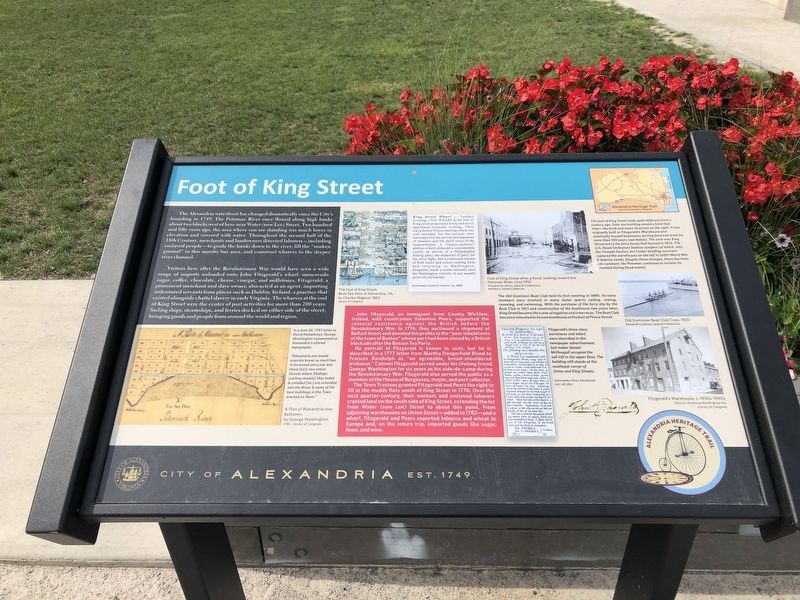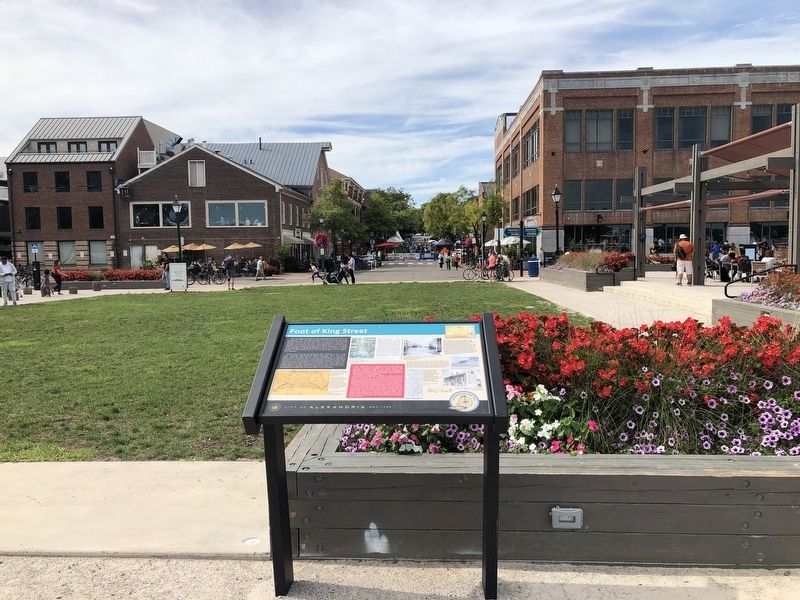Old Town in Alexandria, Virginia — The American South (Mid-Atlantic)
Foot of King Street
Alexandria Heritage Trail
— City of Alexandria, est. 1749 —
The Alexandria waterfront has changed dramatically since the City's founding in 1749. The Potomac River once flowed along the high banks about two blocks west of here near Water (now Lee) Street. Two hundred and fifty years ago, the area where you are standing was much lower in elevation and covered in water. Throughout the second half of the 18th Century, merchants and landowners directed laborers—to grade the banks down to the river, fill the "sunken ground" in this marshy bay area, and construct wharves to the deeper river channel.
Visitors here after the Revolutionary War would have seen a wide range of imports unloaded onto John Fitzgerald's wharf: muscovado sugar, coffee, chocolate, cheese, vinegar, and millstones. Fitzgerald, a prominent merchant and slave owner, also acted as an agent, importing indentured servants from places such as Dublin, Ireland, a practice that existed alongside chattel slavery in early Virginia. The wharves at the end of King street were the center of port activities for more than 200 years. Sailing ships, steamships, and ferries docked on either side of the street, bringing goods and people from around the world and region.
[Sidebar:]
John Fitzgerald, an immigrant from County Wicklow, Ireland, with countryman Valentine Peers, supported the colonial resistance against the British before the Revolutionary War. In 1774, they auctioned a shipment of Belfast linens and donated the profits to the "poor inhabitants of the town of Boston" whose ports had been closed by a British blockade after the Boston Tea Party.
No portrait of Fitzgerald is known to exist, but he is described in a 1777 letter from Martha Dangerfield Bland to Frances Randolph as "an agreeable, broad-shouldered Irishman." Colonel Fitzgerald served under his lifelong friend George Washington for six years as his aide-de-camp during the Revolutionary War. Fitzgerald also served the public as a member of the House of Burgesses, mayor, and port collector.
The Town Trustees granted Fitzgerald and Peers the right to fill in the muddy flats south of King Street in 1778. Over the next quarter-century, their workers and enslaved laborers created land on the south side of King Street, extending the lot from Water (now Lee) Street to about this point. From adjoining warehouses on Union Street—added in 1782—and a wharf, Fitzgerald and Peers exported tobacco and wheat to Europe and, on the return trip, imported goods like sugar, linen, and wine.
[Captions:]
In a June 26, 1797 letter to David Humphreys, George Washington commented on Alexandria's altered topography:
"Alexandria, you would scarcely know;so much has it increased since you was there [sic]; two entire Streets where Shallops [sailing vessels] then laded & unladed [sic] are extended into the River, & some of the best buildings in the Town erected on them."
A Plan of Alexandria now Belhaven, by George Washington, 1749.
The Foot of King Street, Birds Eye View of Alexandria, VA, by Charles Magnus, 1863
King Street Wharf — Sunday Evening—The Wharf at the foot of King street presented a lively and novel appearance yesterday evening. There was a Bethel Prayer meeting which was well attended, but the services were interrupted by the arrival and departure of steamers and the shrill noise of the steamwhistles. A "comico-politico" address which attracted a considerable crowd, an arrival of a Philadelphia fishing party, the departure of party for the prize fight, and a continued stream of both sexes and colors coming from and returning to Washington, altogether made a scene unusual, save the Washington visitors, our usually quiet city on Sunday.
Alexandria Gazette, August 24, 1868
The foot of King Street looks quite different from a century ago. Only one building remains from that time—the brick and stone structure on the right. It was originally built as Fitzgerald's Warehouse and eventually housed businesses serving food and drink for more than 100 years (see below). The arch over King Street led to the ferry house that burned in 1923. The U.S. Naval Ordinance Station complex (of which, only the Torpedo Factory Art Center building survives) replaced the warehouses on the left to fulfill World War II defense needs. Despite these changes, there has been one constant: the Potomac continues to reclaim its riverbed during flood events.
Foot of King Street after a flood, looking toward the Potomac River, circa 1910
The Old Dominion Boat Club held its first meeting in 1880. Its early members were involved in many water sports: sailing, rowing, canoeing, and swimming. With the purchase of the ferry slip by the Boat Club in 1921 and construction of the boathouse two years later, King Street became the scene of regattas and crew races. The Boat Club has since relocated to its new boathouse at the foot of Prince Street.
Old Dominion Boat Club Crew, 1920
Fitzgerald's three-story warehouse and wharf were described in this newspaper advertisement. Sail maker Daniel McDougall occupied the sail loft in the upper floor. The building still stands at the southeast corner of Union and King Streets.
Alexandria Daily Advertiser July 28, 1801
Fitzgerald's Warehouse, c. 1930s-1940s
Erected by the City of Alexandria.
Topics and series. This historical marker is listed in these topic lists: African Americans • Colonial Era • Industry & Commerce • Settlements & Settlers • Waterways & Vessels. In addition, it is included in the Former U.S. Presidents: #01 George Washington, and the Virginia, The City of Alexandria series lists. A significant historical date for this entry is June 26, 1797.
Location. 38° 48.249′ N, 77° 2.357′ W. Marker is in Alexandria, Virginia. It is in Old Town. Marker is on King Street east of Strand Street. Touch for map. Marker is at or near this postal address: 1 King St, Alexandria VA 22314, United States of America. Touch for directions.
Other nearby markers. At least 8 other markers are within walking distance of this marker. Waterfront Walk (a few steps from this marker); The Domestic Slave Trade (within shouting distance of this marker); River Ferries (within shouting distance of this marker); George Henry, Enslaved Ship Captain (within shouting distance of this marker); Plundered! (within shouting distance of this marker); Raise the White Flag (within shouting distance of this marker); Pioneer Mill (within shouting distance of this marker); Alexandria Archaeology Museum (within shouting distance of this marker). Touch for a list and map of all markers in Alexandria.
Additional keywords. human trafficking
Credits. This page was last revised on May 25, 2023. It was originally submitted on September 27, 2021, by Devry Becker Jones of Washington, District of Columbia. This page has been viewed 371 times since then and 43 times this year. Photos: 1, 2. submitted on September 27, 2021, by Devry Becker Jones of Washington, District of Columbia.

